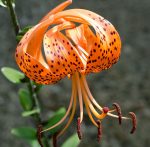 Native to China, Japan, Korea and far eastern Russia, this vigorous, easy to grow perennial bulb is a member of the Liliaceae family that also includes tulip, crown imperial, and dog’s tooth violet. The plant grows 3-5′ tall and has unbranched stems that are purple to almost black and covered with white hairs. The lanceolate leaves leaves are 3-7″ long and have distinct parallel veins. One to three bulbets are produced in the axils of the upper leaves and are a means of asexual reproduction. The 5″ flowers appear in mid-summer and are orange with maroon to black spots, and nodding with reflexed petals. Up to 40 flowers may be produced by a single stem although 12-20 is more likely. Although the flowers lack fragrance their striking color makes them a good choice for a border, cottage garden, and container as well as for the vase where they may last for up to two weeks. They are especially attractive when planted in clumps of at least 3. The plants have escaped gardens from New England to Georgia and west to Minnesota and Illinois and may be considered weedy. In addition, the plants are poisonous to cats. The genus name, Lilium, comes from the Greek word λείριον (leírion) and probably originally referred to white lilies like the Madonna Lily. The specific epithet, lancifolium comes from the Latin words lancea, meaning spear, and folium, meaning leaf, referring to the shape of the leaves.
Native to China, Japan, Korea and far eastern Russia, this vigorous, easy to grow perennial bulb is a member of the Liliaceae family that also includes tulip, crown imperial, and dog’s tooth violet. The plant grows 3-5′ tall and has unbranched stems that are purple to almost black and covered with white hairs. The lanceolate leaves leaves are 3-7″ long and have distinct parallel veins. One to three bulbets are produced in the axils of the upper leaves and are a means of asexual reproduction. The 5″ flowers appear in mid-summer and are orange with maroon to black spots, and nodding with reflexed petals. Up to 40 flowers may be produced by a single stem although 12-20 is more likely. Although the flowers lack fragrance their striking color makes them a good choice for a border, cottage garden, and container as well as for the vase where they may last for up to two weeks. They are especially attractive when planted in clumps of at least 3. The plants have escaped gardens from New England to Georgia and west to Minnesota and Illinois and may be considered weedy. In addition, the plants are poisonous to cats. The genus name, Lilium, comes from the Greek word λείριον (leírion) and probably originally referred to white lilies like the Madonna Lily. The specific epithet, lancifolium comes from the Latin words lancea, meaning spear, and folium, meaning leaf, referring to the shape of the leaves.
Type: Perennial bulb
Bloom: Non-fragrant, nodding flowers with reflexed orange tepals bearing maroon to black spots in mid summer
Size: 2-5′ H
Light: Full to partial sun
Soil: Average, consistently moist, well-drained
Hardiness: Zones 5-7
Care: Low maintenance
Pests and Diseases: None of significance
Propagation: Seed, bulbets
Companion Plants: Globe thistle, sea holly, purple cone flower
Outstanding Selections:
‘Splendens'”
Lilium tigrinum flore pleno (double flower)
Photo Credit: Wikipedia